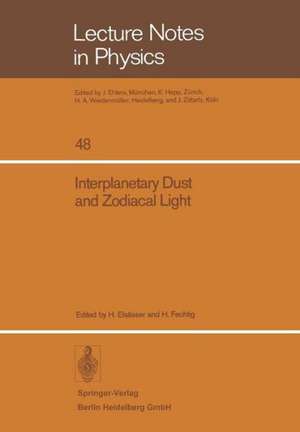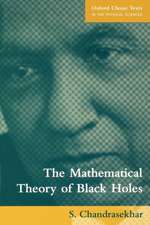Interplanetary Dust and Zodiacal Light: Proceedings of the IAU-Colloquium No. 31, Heidelberg, June 10–13, 1975: Lecture Notes in Physics, cartea 48
Editat de H. Elsässer, H. Fechtigen Limba Engleză Paperback – mai 1976
Din seria Lecture Notes in Physics
- 19%
 Preț: 423.99 lei
Preț: 423.99 lei - 17%
 Preț: 360.73 lei
Preț: 360.73 lei -
 Preț: 429.22 lei
Preț: 429.22 lei - 17%
 Preț: 427.62 lei
Preț: 427.62 lei - 17%
 Preț: 460.25 lei
Preț: 460.25 lei -
 Preț: 427.96 lei
Preț: 427.96 lei -
 Preț: 481.93 lei
Preț: 481.93 lei - 17%
 Preț: 494.64 lei
Preț: 494.64 lei -
 Preț: 281.90 lei
Preț: 281.90 lei - 17%
 Preț: 493.20 lei
Preț: 493.20 lei - 17%
 Preț: 426.72 lei
Preț: 426.72 lei -
 Preț: 365.15 lei
Preț: 365.15 lei -
 Preț: 374.52 lei
Preț: 374.52 lei -
 Preț: 407.98 lei
Preț: 407.98 lei - 20%
 Preț: 428.12 lei
Preț: 428.12 lei -
 Preț: 263.30 lei
Preț: 263.30 lei - 15%
 Preț: 593.73 lei
Preț: 593.73 lei - 15%
 Preț: 528.13 lei
Preț: 528.13 lei -
 Preț: 493.12 lei
Preț: 493.12 lei - 17%
 Preț: 425.68 lei
Preț: 425.68 lei -
 Preț: 280.65 lei
Preț: 280.65 lei -
 Preț: 163.41 lei
Preț: 163.41 lei - 18%
 Preț: 726.59 lei
Preț: 726.59 lei -
 Preț: 394.84 lei
Preț: 394.84 lei - 15%
 Preț: 709.63 lei
Preț: 709.63 lei - 15%
 Preț: 623.90 lei
Preț: 623.90 lei - 20%
 Preț: 476.91 lei
Preț: 476.91 lei - 15%
 Preț: 428.05 lei
Preț: 428.05 lei -
 Preț: 342.78 lei
Preț: 342.78 lei - 18%
 Preț: 851.93 lei
Preț: 851.93 lei -
 Preț: 346.61 lei
Preț: 346.61 lei -
 Preț: 391.57 lei
Preț: 391.57 lei - 15%
 Preț: 633.16 lei
Preț: 633.16 lei -
 Preț: 451.71 lei
Preț: 451.71 lei - 5%
 Preț: 1497.80 lei
Preț: 1497.80 lei -
 Preț: 374.85 lei
Preț: 374.85 lei -
 Preț: 380.07 lei
Preț: 380.07 lei - 15%
 Preț: 516.14 lei
Preț: 516.14 lei - 15%
 Preț: 583.78 lei
Preț: 583.78 lei - 15%
 Preț: 508.60 lei
Preț: 508.60 lei -
 Preț: 469.71 lei
Preț: 469.71 lei -
 Preț: 388.90 lei
Preț: 388.90 lei - 15%
 Preț: 500.24 lei
Preț: 500.24 lei -
 Preț: 386.52 lei
Preț: 386.52 lei - 15%
 Preț: 472.88 lei
Preț: 472.88 lei -
 Preț: 424.27 lei
Preț: 424.27 lei -
 Preț: 380.07 lei
Preț: 380.07 lei - 15%
 Preț: 500.01 lei
Preț: 500.01 lei
Preț: 654.62 lei
Preț vechi: 770.14 lei
-15% Nou
Puncte Express: 982
Preț estimativ în valută:
125.26€ • 131.11$ • 104.26£
125.26€ • 131.11$ • 104.26£
Carte tipărită la comandă
Livrare economică 31 martie-14 aprilie
Preluare comenzi: 021 569.72.76
Specificații
ISBN-13: 9783540076155
ISBN-10: 3540076158
Pagini: 516
Ilustrații: XII, 501 p.
Dimensiuni: 170 x 244 x 27 mm
Greutate: 0.81 kg
Ediția:1976
Editura: Springer Berlin, Heidelberg
Colecția Springer
Seria Lecture Notes in Physics
Locul publicării:Berlin, Heidelberg, Germany
ISBN-10: 3540076158
Pagini: 516
Ilustrații: XII, 501 p.
Dimensiuni: 170 x 244 x 27 mm
Greutate: 0.81 kg
Ediția:1976
Editura: Springer Berlin, Heidelberg
Colecția Springer
Seria Lecture Notes in Physics
Locul publicării:Berlin, Heidelberg, Germany
Public țintă
ResearchCuprins
Space observations of the zodiacal light.- Helios zodiacal light experiment.- Preliminary results of the helios a zodiacal light experiment.- Pioneer 10 observations of zodiacal light brightness near the ecliptic: Changes with heliocentric distance.- Star counts in the background sky observed from pioneer 10.- The S10 (V) unit of surface brightness.- Polarization of the zodiacal light: first results from skylab.- Photometry of the zodiacal light with the balloon — borne telescope thisbe.- OSO-5 Zodiacal Light Measurements 1969–1975.- Evidence for scattering particles in meteor streams.- The ultraviolet scattering efficiency of interplanetary dust grains.- Summary of observations of the solar corona/inner zodiacal light from Apollo 15, 16, and 17.- A temporal study of the radiance of the F-corona close to the sun.- Measurements of the T-corona from daily OSO=7 observations.- The thermal emission of the dust corona during the eclipse of June 30, 1973.- The color characteristics of the earth-moon libration clouds.- A search for forward scattering of sunlight from the lunar libration clouds.- Presemtation of Zodiacal Light instrument aboard the D2B astronomical satellite.- Visible and UV photometry of the gegenschein and the milky way.- Ground-based observations of the zodiacal light.- Polarimetry of the zodiacal light and milky way from Hawaii.- Scattering in the earth's atmosphere: Calculations for milky way and zodiacal light as extended sources.- Scattering layer of cosmic dust in the upper atmosphere.- Some formulae to interpret zodiacal light photopolarimetric data in the ecliptic from ground or space.- Discussion of the rocket photometry of the zodiacal light.- Consequences of the inclination of the zodiacal cloud on the ecliptic.- Method for the determination ofthe intensity of scattered sunlight per unit-volume of the interplanetary medium.- On the visibility of the libration clouds.- Scattering functions of dielectric and absorbing irregular particles.- The compatibility of recent micrometeoroid flux curves with observations and models of the zodiacal light.- In-situ records of interplanetary dust particles — methods and results.- Preliminary results of the micrometeoroid experiment on board helios A.- Composition of impact-plasma measured by a HELIOS-micrometeoroid-detector.- Orbital elements of dust particles intercepted by pioneers 8 and 9.- Flux of hyperbolic meteoroids.- The cosmic dust environment at earth, jupiter and interplanetary space results FRO, Langley experiments on MTS, Pioneer 10, and Pioneer 11.- Dust in the outer solar system - review of early results from Pioneers 10 and 11.- Sources of interplanetary dust: Asteroids.- Lunar microcraters and interplanetary dust fluxes.- The size frequency distribution and rate of production of microcraters.- The long term population of interplanetary micrometeoroids.- Lunar soil movement registerd by the apollo 17 cosmic dust experiment.- lectrostatic disruption of lunar dust particles.- Microcraters produced by oblique incidence of projectiles.- Measurements of Impact Ejecta Parameters in Crater Simulation Experiments.- Impact light flash studies: Temperature, Ejecta, Vaporization.- Submicron Particles from the Sun.- Analysis of impact craters from the S-149 Skylab experiment.- Micrometeorite impact craters on Skylab EXPERIMENT S-149.- Extraterrestrial particles in the stratosphere.- Magellan collections of large cosmic dust particles.- Specific sources of extraterrestrial particles.- Near-earth fragmentation of cosmic dust.- Dust in comets and interplanetary matter.-The production rate of dust by comets.- Can short period comets maintain the zodiacal cloud?.- Optical properties of cometary dust.- The dust coma of comets.- Dust emission from Comet Kohoutek (1973f) at large distances from the sun.- Predicted favorable visibility conditions for anomalous tails of comets.- Study of the anti-tail of Comet Kohoutek from an observation on 17 January 1974.- Condensation processes in high temperature clouds.- Mariner mission to Encke 1980.- Meteors and interplanetary dust.- Meteoroid densities.- Possible evidence of meteoroid fragmentation in interplanytary space from grouping of particles in meteor streams.- The heliocentric distribution of the meteor bodies at the vicinity of the earth's orbit.- Fireballs as an atmospheric source of meteoritic dust.- Interplanetary dust in the vicinity of the earth.- Meteor radar rates and the solar cycle.- Evolution and detectability of interplanetary dust streams.- On the structure of hyperbolic interplanetary dust streams.- Expected distribution of some of the orbital elements of interstellar particles in the solar system.- Sources of interplanetary dust.- Dynamics of interplanetary duest and related topics.- Modeling of the orbital evolution of vaporizing dust particles near the sun.- Orbital evolution of circum-solar dust grains.- Temperature distribution and lifetime of interplanetary ice grains.- Radial distribution of meteoric particles in interplanetary space.- Rotational bursting of interplanetary dust particles.- Lunar ejecta in heliocentric space.- Radiation pressure on interplanetary dust particles.- Are interplanetary grains crystalline?.- A Technique for measuring the interstellar component of cosmic dust.- The zodiacal light.- In situ measurements of dust.- Can comets be the only source of interplanetary dust?.- Meteors.- Final remarks.













